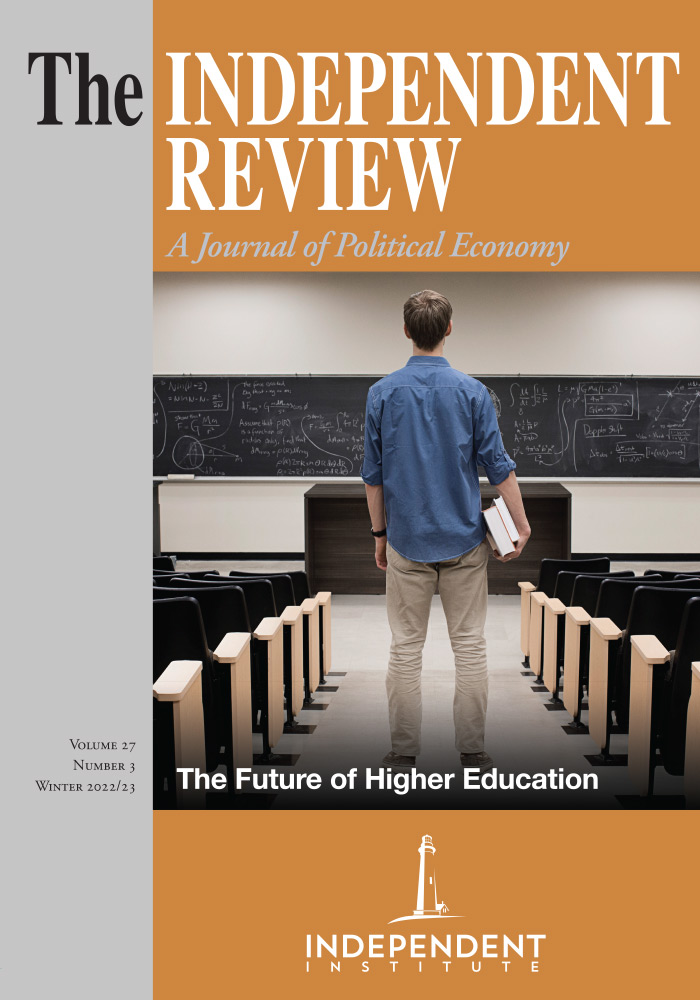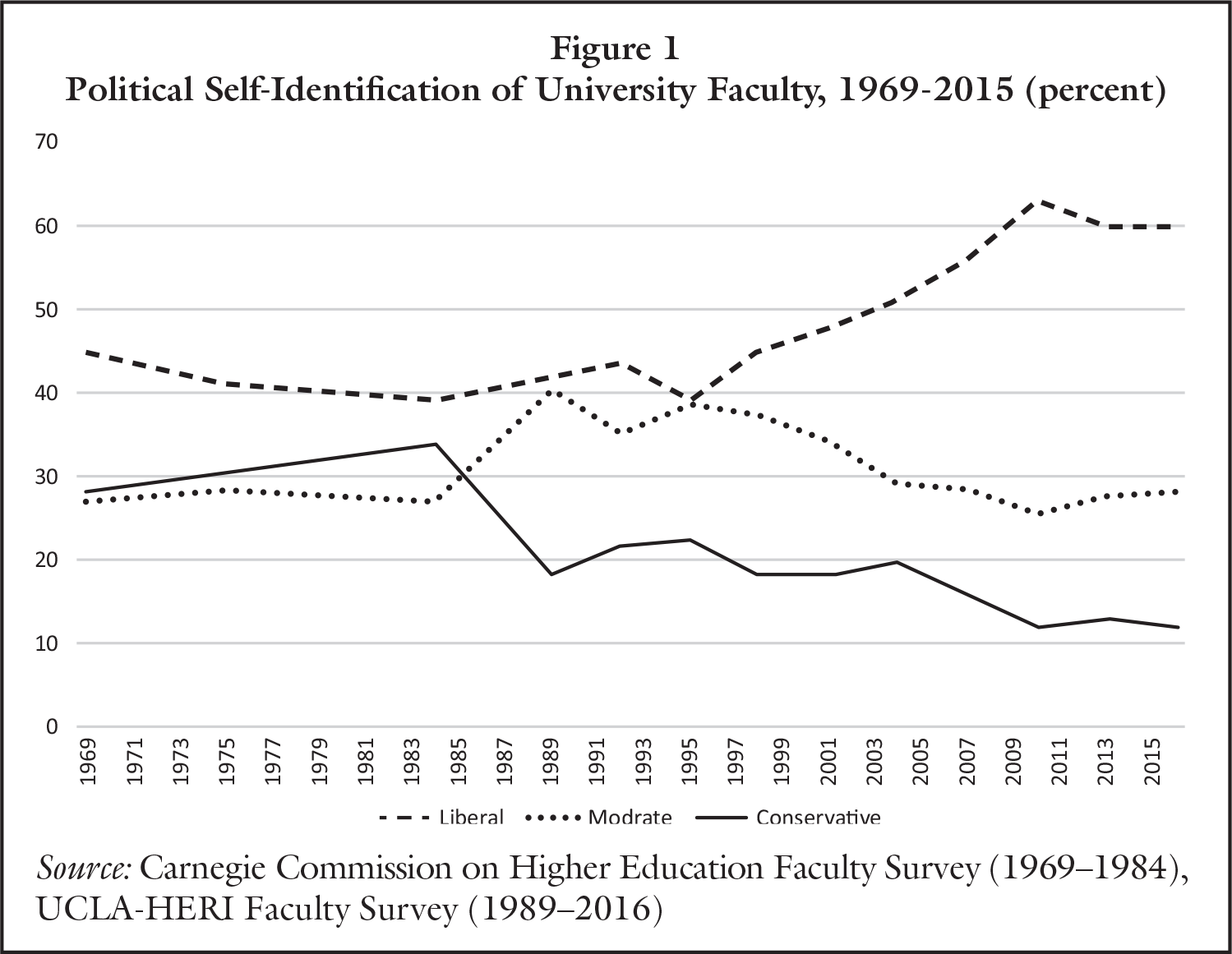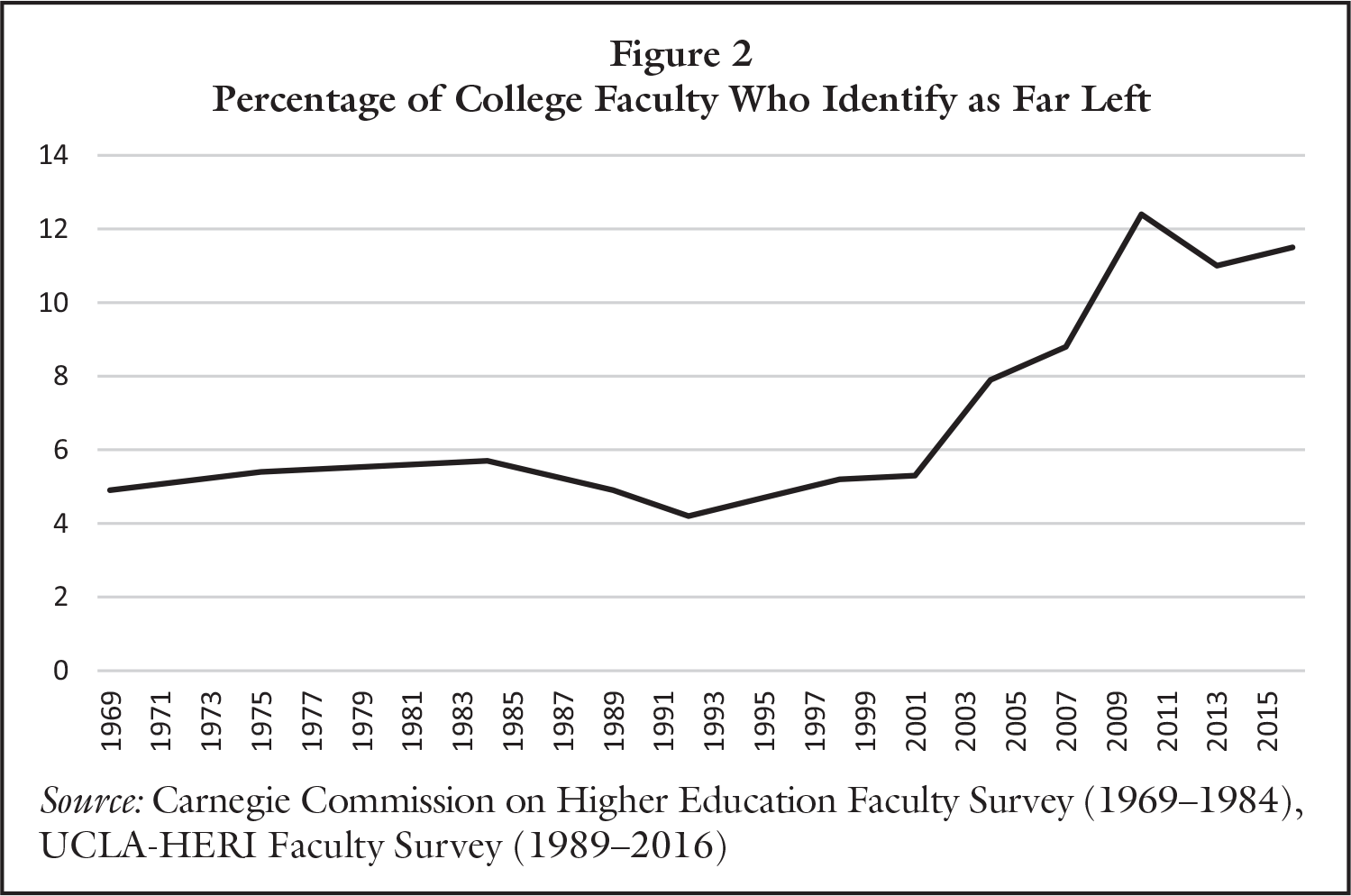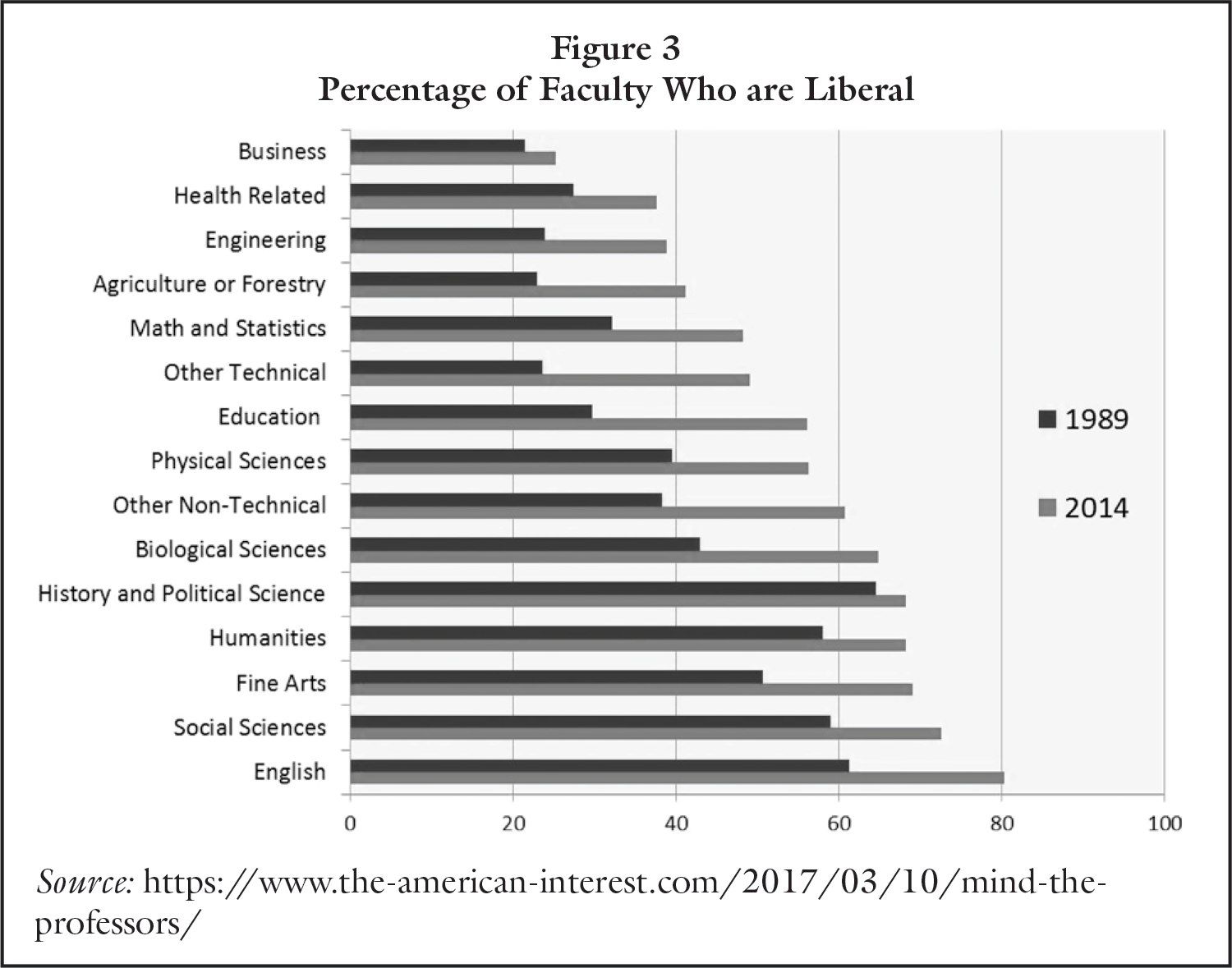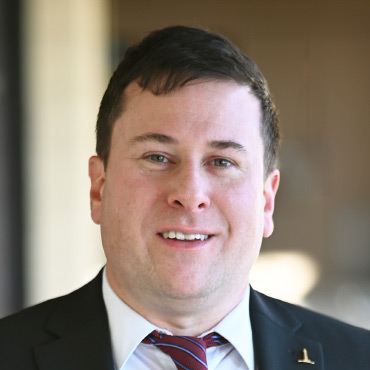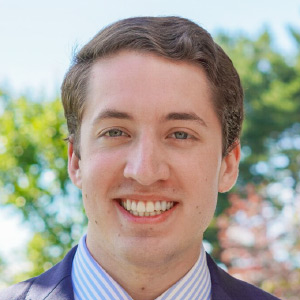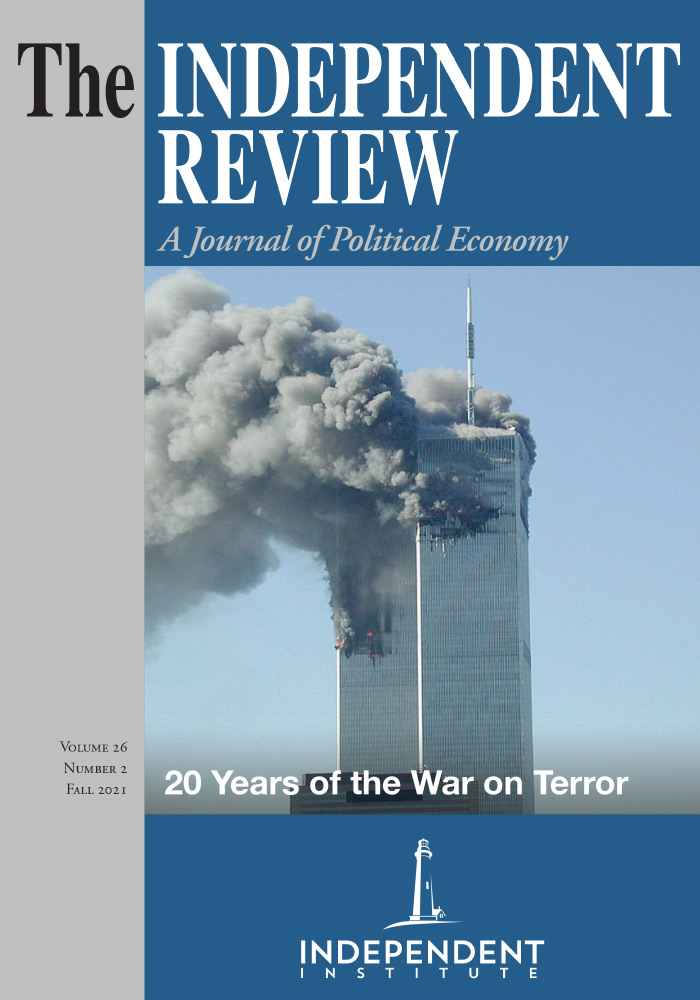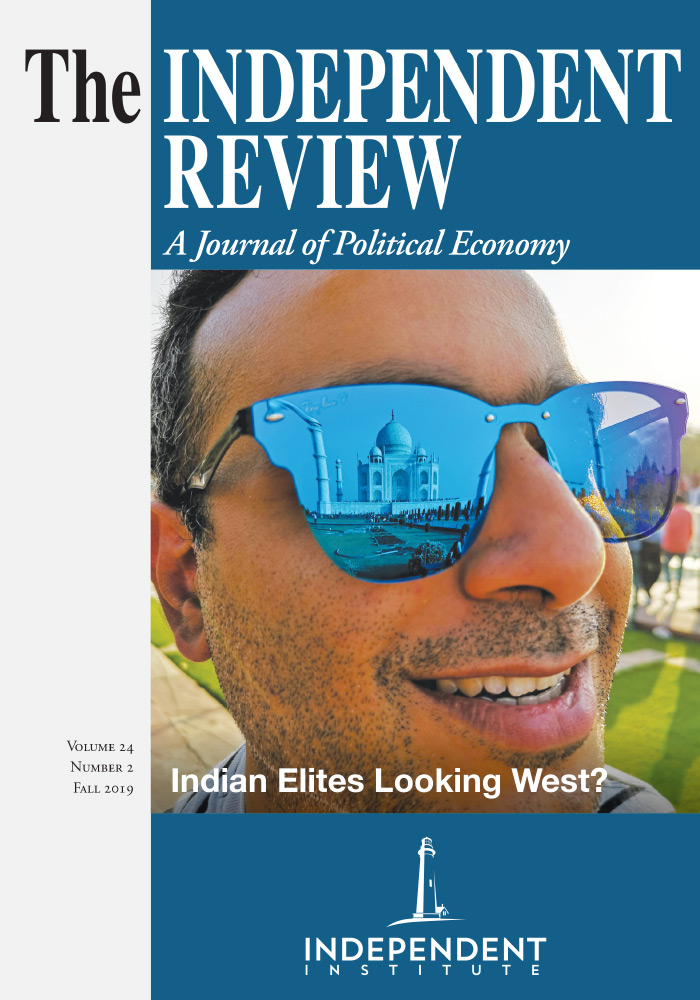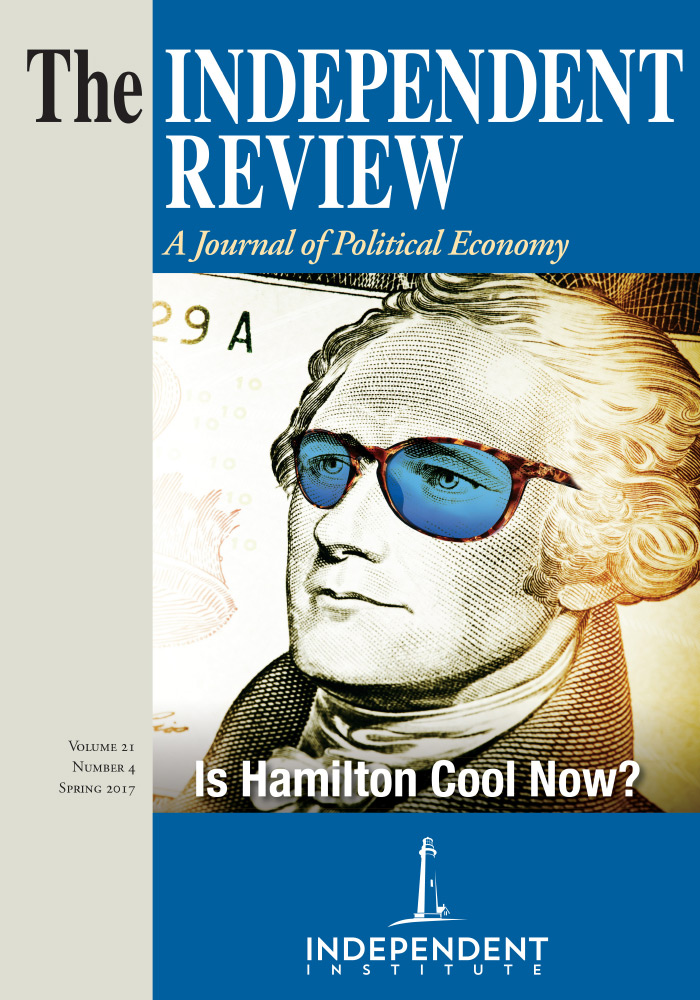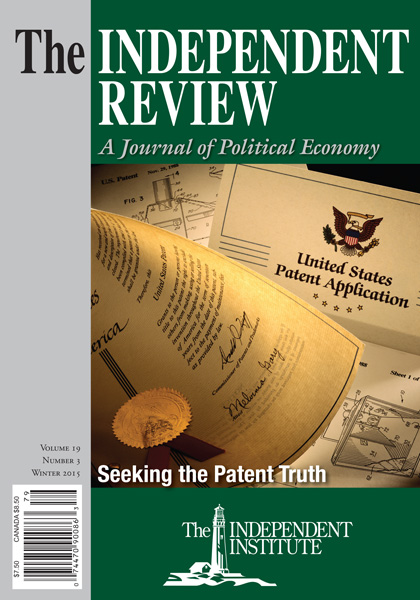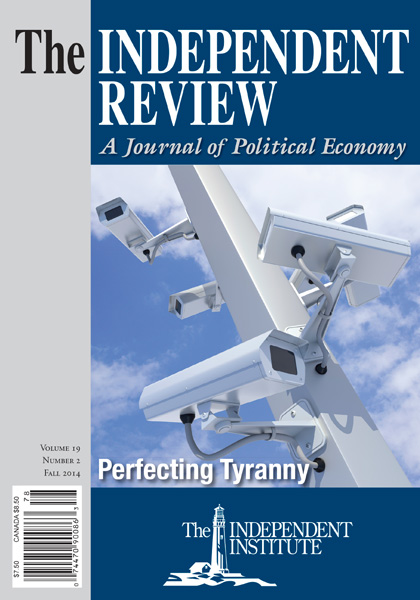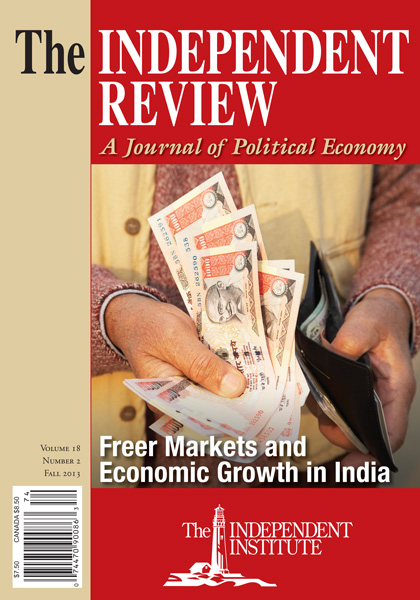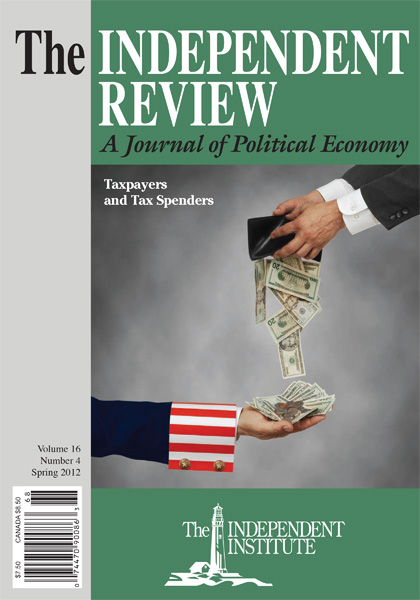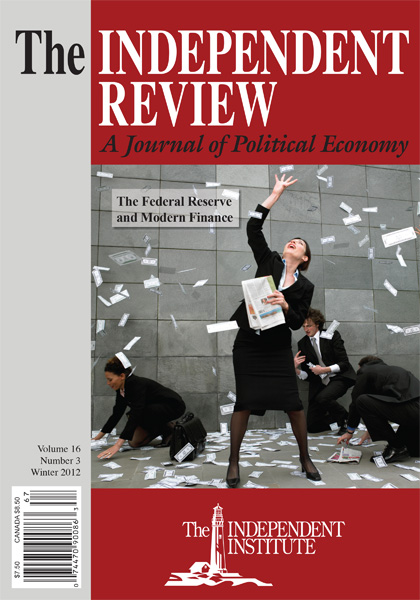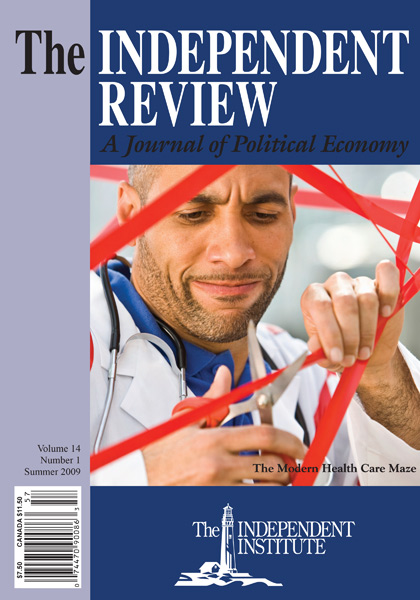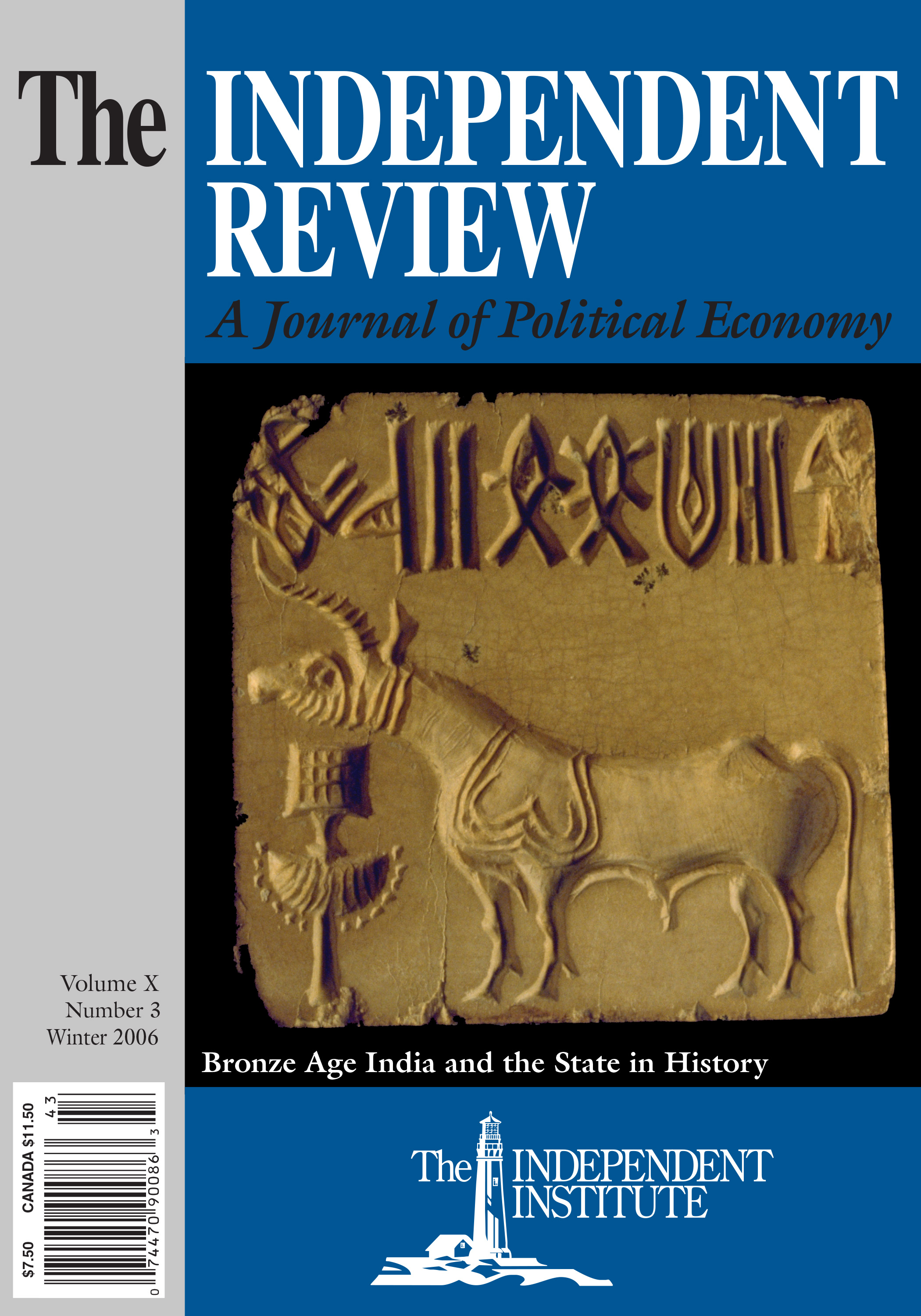Higher education has recently made a hard left turn—sixty percent of faculty now identify as “liberal” or “far left.” This left-leaning supermajority is responsible for rampant discrimination against non-left job seekers, both conservatives and moderates, and the trend is likely to worsen. This essay predicts that faculty who embrace this shift do so at their own peril, as they invite greater democratic oversight from a public which realizes higher education no longer aligns with its values and educational priorities.
Article
The archetype of the “radical tenured college professor” has long had an empirical basis in political surveys of academics. Since the earliest measures in the 1960s, the modal college professor has sat to the political left of the American public. Until very recently, however, this overall skew obscured an underlying stability in the political composition of faculty. Between 1969 and 1998, the share of faculty identifying as “liberal” or “far-left” shifted only a tenth of a percentage point, from 44.7 percent to 44.8 percent.
Beginning with the next survey, in 2001, however, faculty opinion took a hard left turn such that professors on the political left are now approaching a supermajority in the academy (see figure 1). Although faculty opinions developed a pronounced political skew in the past two decades, student views have not followed suit. Survey data for incoming first-year students shows long-term fluctuations on the left and right but also a clear plurality at the political center (Higher Education Research Institute 1970–present). As a result, a widening political gap now exists between professors and the students they teach, with the latter exhibiting a more representative slice of the general public.
These trends point to the imperiled state of viewpoint diversity in higher education. Although higher ed still draws primarily from the general public for both student tuition and tax-dollar funding, its political fulcrum is increasingly mismatched with the society it purports to serve. To compound matters further, many prominent voices in higher education have responded to signs of its emerging ideological monoculture by either denying the empirical evidence or embracing the post-1998 shift as a positive good.
In this analysis, we briefly examine the history of faculty political composition and its implications for the learning environment of higher education. We conclude by echoing the concerns of James M. Buchanan (1999), who predicted that the politicization of university faculty would ultimately undermine public confidence in higher education, and with it, public budgetary support for our university system.
The History of Faculty Political Surveys
Although conservative public intellectuals have drawn attention to the leftward political biases of academia since at least the publication of God and Man at Yale (Buckley 1951), the academic literature and empirical evidence of the phenomenon, specifically directed toward higher ed faculty bias, did not emerge until the late 1960s and early 1970s.
In 1971, political scientists Seymour Martin Lipset and Everett Ladd first called attention to the ideological distribution of university faculty by placing it on an empirical footing. Working with the Carnegie Commission on Higher Education survey of more than one hundred thousand full-time professors at more than three hundred institutions, Lipset and Ladd identified a left-leaning plurality in university faculty ranks. Their analysis further documented a clear political divide within faculty ranks. Faculty in the liberal arts exhibited a stronger leftward disposition, and stronger political views in general, than faculty in the natural sciences. Although these patterns evinced some stability, they also warranted close attention and monitoring in the eyes of these authors. If the political distribution of the universities became skewed in one direction and mismatched with the public, public trust in universities would expectedly suffer.
Importantly, Lipset and Ladd’s work established the first true empirical baseline for measuring faculty opinion over time. Throughout the 1970s and 1980s, numerous academics responded to Lipset and Ladd by suggesting that concerns about a politically skewed faculty were overstated. In “The Myth of the Liberal Professor,” for example, Michael A. Faia contended that “[a] majority of professors describe themselves as being to the right of liberalism—a tendency that seems to be increasing—and the professorial lifestyle does not appear to be particularly liberalizing” (1974, 171).
The literature in the 1970s and 1980s largely focused on how professors responded to the great political issues of the day. These included events such as the Vietnam War, campus protests, sit-ins, South African divestment, and race and gender issues. There is no clear ideological story to tell in a number of respects here, as these sorts of observations do not hold up particularly well over time. What were once radical positions are not necessarily so any longer, something that must be remembered with any conclusions that are offered.
The very nature of political inquiry is implicated here as well. Some argue that because academia focuses on expanding ideas, it is inherently opposed to conservatism, which seeks, in a nod to Buckley, to yell “Stop!” In some respects, a liberal-leaning academia should be expected to some degree. The confounding reality now, though, is that many liberal academics agree it is vital to limit ideas they deem harmful.
At the same time, however, these issues simultaneously shaped the general public’s political distribution. The emergence of a gap between the public and the professoriate over time accordingly cannot be explained by the specific political issues of a given decade. Instead, it signals the changing ideological composition of those who seek out faculty careers or, potentially, an emerging bias in how political viewpoints are treated through academic hiring and retention practices.
In the 1990s, responses to Ladd and Lipset claimed the leftward tilt of academia was diminishing, albeit slightly. In 1993, Richard F. Hamilton and Lowell L. Hargens used data from the 1969, 1975, and 1984 Carnegie surveys, finding,
Given the recent sounds of alarm, one would expect to find clear evidence of liberal and leftist growth. Evidence for the period 1969–84, however, does not confirm that expectation. The self-identified Left was fairly constant over this period. ... Middle-of-the road positioning, in the aggregate, was unchanged. Conservative identifications, both moderate and strong, showed increases, these together being approximately equal to the liberal losses. The overall or net tendency, clearly, was toward greater conservatism (607).
Today, however, the picture is quite different. Unlike the thirty-year debate over Lipset and Ladd’s findings, today’s surveys demonstrate a shift from the once-stable liberal plurality toward an unambiguous expansion of left-wing political views among American academics. Since 1989, the UCLA-Higher Education Research Institute (HERI) has maintained a successor faculty survey that asks professors to identify their political leanings every three years (figure 1).
According to the most recently available HERI survey, liberal and far-left faculty members grew from 44.8 percent in 1998 to 59.8 percent in 2016–17. Liberal and far-left faculty no longer make up a plurality of American academics. They are now the clear majority.
The primary driver of this leftward shift is the growth of faculty members who identify as far left. Since 1992, this group has expanded from 4.2 percent to 11.5 percent of all university faculty. In sum, far-left faculty tripled in size and now sit at parity with all conservative faculty (figure 2).
Although this trend is more pronounced in some academic disciplines than others, each domain has increased in left-wing identification since the 1990s. Samuel Abrams (2017) analyzed the HERI survey data across disciplines and found a uniform leftward political shift in every discipline between 1989 and 2014 (figure 3). At the same time, he confirmed that the gap between the liberal arts and hard sciences, first noticed in Lipset and Ladd’s work, had dramatically increased. Whereas most STEM disciplines and professional degrees in fields such as healthcare and business still maintain a semblance of viewpoint diversity among their faculty, the humanities and social sciences have become monolithically left-leaning. In some fields such as English and history, self-identified moderate faculty have diminished to a tiny minority, and conservatives are practically nonexistent.
An Academy in Denial
As the data from faculty surveys shifted heavily leftward in recent years, some academics have responded by denying these trends exist. A recent example can be found in the work of Charlie Tyson and Naomi Oreskes (2020a), who, in “The American University, the Politics of Professors and the Narrative of ‘Liberal Bias,’” present inaccurate and obfuscatory claims in an attempt to refute the clear empirical patterns illustrated in the foregoing section.
Tyson and Oreskes contend the sharp leftward shift in academia is overstated, claiming that “most professors self-identify as moderates of one kind or another” (15). They dismiss the recent trends in the HERI survey by misdirection, contending that it only “chart[s] a slight rise in professorial liberalism” (20) and concluding “[t]here is no evidence, however, for a dramatic leftward shift in the American professoriate as a population”(20).
When confronted with the clear evidence of the HERI survey’s rapid 15 percentage point shift, Tyson and Oreskes attacked the validity of the survey instrument itself by contending that “only one [of its questions] is about politics” (2020b), suggesting it is inadequate for the task of measuring faculty opinion. In its place, they endorse an alternative survey by Neil Gross and Solon Simmons (2014), which placed the faculty at about 44 percent liberal-leaning as of 2006. Both claims warrant closer investigation.
First, the HERI survey and its predecessors have long included other questions related to the political climate on campus. In the 1989–90 HERI survey, only 21 percent of faculty indicated that their institutions placed a high priority on “help[ing] students learn how to bring about change in American society” (23). This figure increased to 33.2 percent in 2004–2005, and 45.8 percent by the 2016–17 survey. The 2007–2008 HERI survey added a question asking faculty whether they saw it as their own personal role to “encourage students to become agents of social change,” (4) with 57.8 percent placing a high importance on this task. By 2016–17, this number increased to 80.6 percent of all faculty. Together, these data indicate that the leftward ideological shift among the professoriate has been accompanied by a clear rise in instructional approaches that prioritize political activism in the classroom.
Tyson and Oreskes’s reliance on the older Gross and Simmons survey also leads them to an erroneous inference due to a simple matter of timing. This survey is now over a decade out of date compared to the most recent HERI data. Gross and Simmons found that approximately 44 percent of faculty identified on the political left as of 2006, which placed it roughly in line with the 51 percent found in the 2004–2005 HERI survey. Gross and Simmons have not updated their measures since that time, even though the subsequent decade accounts for the overwhelming majority of the leftward shift in more recent survey data. In this sense, Tyson and Oreskes’s use of outdated data appears to be an act of misdirection to avoid contending with the more recent leftward shift.
To bolster their counterargument, Tyson and Oreskes claim there is an anti-humanities bias in the literature on faculty politics, because more students major in less-politicized fields such as business and the STEM disciplines. This assertion is dubious for two reasons. First, survey data tend to suggest that business and STEM faculty are still situated on the center-left side of the American political spectrum (Langbert 2018). They simply have not reached the near-monolithic far-left skew that is found in the humanities. When viewed from Tyson and Oreskes’s humanities vantage point, the comparative balance of the STEM disciplines looks “right wing.” But this is entirely a relic of the extreme skew currently found in most humanities disciplines.
Second, while Tyson and Oreskes correctly point to the growing popularity of business and STEM majors, they neglect the heavy curricular presence of mandatory general education classes in almost all undergraduate degree requirements. Humanities classes enjoy a disproportionate presence on the general education curriculum, and accordingly have a much larger footprint within the faculty on most campuses (Brennan and Magness 2019, 169–73). Almost all students take several semesters of mandatory courses in English, history, and other heavily politicized disciplines. By contrast, business and STEM classes are far less likely to be required as a condition of graduation. This implies that the average college student will experience extensive mandatory instruction in the most heavily skewed disciplines, irrespective of major, whereas only business and STEM majors will encounter the comparative political balance that is found within their chosen fields.
In addition to their assertion of an anti-humanities bias, Tyson and Oreskes go further, claiming the bias in the humanities is due to a lack of interest among nonleftists in studying those subjects.
This claim ignores extensive and growing evidence that disciplines with hard leftward political skews engage in hiring discrimination against nonleft faculty. Several indicators suggest that ideological hiring discrimination is a systemic problem in left-leaning academic disciplines. For example, a rigorous empirical analysis by Phillips (2018) found that conservative law school graduates who enter academia usually place at lower ranked institutions than their left-leaning peers. This bias remains after controlling for meritocratic hiring factors, such as the number and strengths of publications on an applicant’s CV. Survey data within disciplines similarly indicate an alarming willingness of faculty on the left to openly discriminate against other political viewpoints in hiring decisions. Many psychology faculty openly admit to hiring discrimination against nonleftist faculty applicants (Inbar and Lammers 2012), and (Peters et al. 2020) find similar discriminatory practices in philosophy.1
Because these data come from self-admission, it is likely that they also understate the severity of political discrimination in these fields, including that arising from unadmitted or subconscious biases.
In addition to Tyson and Oreskes, other scholars on the left have attempted to distract attention away from the post-1998 faculty survey data by crafting historical narratives that allege a bias in the opposite direction. According to this literature, conservative philanthropy on college campuses has created a disproportionate presence of right-leaning faculty in certain disciplines.
In “Literature Review: Conservative Philanthropy in Higher Education,” David Walsh (2019) asserts that right-leaning philanthropy from the Olin Foundation, Koch foundations, and the Federalist Society have artificially increased the presence of conservatives within faculty ranks. In Walsh’s words, these efforts “normalized right-wing politics in the academy to an extent conservatives could have barely imagined in the 1960s” (15). He claims that conservative philanthropy creates a “trickle down” effect of right-wing influence within academia, wherein conservative graduates of elite programs filter into the rest of academia. To Walsh, this represents a “transformation” in higher education. Walsh’s account, however, is entirely anecdotal and presented with no empirical basis of comparison to gauge the size of conservative influence. It also conveniently sidesteps the heavy presence of left-leaning philanthropy in research funding, including entities such as the Ford Foundation, the Hewlett Foundation, and the Open Societies Foundation.
The resulting argument amounts to little more than stringing together a series of cherry-picked philanthropic efforts in an attempt to generalize them as part of a bigger picture of the U.S. university system. When faced with data, this narrative of increasing right-wing influence falls apart. To the contrary of this claim, figure 1 shows a rapidly dwindling share of faculty positions held by right-leaning professors of any stripe. Although studying conservative philanthropy might be an interesting academic endeavor, ramming anecdotes about conservative funders into a bigger picture of supposed “right-wing infiltration” while ignoring the empirical evidence demonstrating a leftward shift within higher education is simply deceptive.
Conclusion
It is not necessarily problematic for professors to all lean one way or the other politically, as long as they are committed to free and open inquiry. Problems arise, however, when academics obfuscate and deny the reality surrounding the political ideologies of university faculty. It is now a clear empirical fact that since the early 2000s, trends in faculty political identification have moved sharply leftward, yielding a 15 percentage point shift in as many years. Accompanying this shift, faculty and university administrators have increasingly prioritized overt political activism as a primary emphasis of classroom instruction. The changing ideological landscape has not only made nonleft constituencies feel increasingly unwelcome on campus—it has also started to materialize in hiring discrimination against faculty applicants with nonleft perspectives in several of the most politically skewed disciplines.
In 1971, James M. Buchanan predicted a decline in academic standards due to the politicization of the faculty and an increasing turn toward activism in the place of traditional research. This prediction also conveyed an implication for the future of universities: if the ideological objectives of the faculty diverged from the general public’s expectations for higher education, it would eventually imperil the willingness of voters to provide public support for university systems. Today, Buchanan’s warning has become reality. Ironically, shoddy efforts by academics to obscure the leftward hyperpoliticization of the university system only further demonstrate Buchanan’s point. Unfortunately, like Buchanan, in 2022 we also see “no signs of increasing critical awareness along with a return to tolerance” (270). only an increase in the opposite behavior.
What is to be done?
It is hard to see a future in which these disturbing trends do not continue within the traditional university model. That said, change does not have to come from within. Although modern universities are heavily subsidized and unlikely to change, students are not bound to attend them to satisfy their educational goals. Recent data reveal wide variation in the popularity of college majors by subject area. Many STEM and professional programs have gained majors since the early 2010s, whereas several subjects in the humanities and social sciences went into rapid decline in the same period. History, English, foreign languages, philosophy, anthropology, and political science all posted losses of roughly 10 to 32 percent of their 2011 totals (Schmidt 2018). Although many factors influence these trends, the most rapidly declining majors invariably exhibit hyperpoliticized faculty ranks that draw almost exclusively from the left. Perhaps students are already voting with their feet, although the effects are likely dampened by high representation of the same subjects in the mandatory general education curriculum.
Echoing Buchanan’s warning, a larger question remains about the taxpaying public’s willingness to continue subsidizing a university system when they are increasingly alienated from its politics. Higher education historically enjoys public support based on the premise that it provides societal returns such as scientific discovery, curation of knowledge, and a better-educated population. These returns become ambiguous when faculty ranks no longer reflect the diversity of viewpoints found in the general public, and they may even constitute a net negative in certain departments that eschew scholarly production in pursuit of far-left political activism. Faculty who embrace and defend this shift do so at their own peril, as they invite greater democratic oversight of their activities as a matter of public finance.
A final consideration suggests that the political climate on campus may continue to worsen before student and public pressures make them financially unsustainable. This article focuses on university faculty, but the politicization of administrators is far worse. As Samuel Abrams (2018) has documented, left-leaning administrators dominate their conservative counterparts by a ratio of twelve to one, compared to a six to one ratio for university faculty. Comparatively little empirical work has been done on administrative political skew aside from Abrams’s survey. We suggest one probable explanation: administrative hiring tends to draw more heavily from the most politically skewed disciplines, many of which have an enormous glut of Ph.D. graduates and few faculty jobs to hire them.
A hyperpoliticized academy does not bode well for students, faculty, or anyone interested in serious learning. For many students and for an increasing share of the general public, this has turned the educational experience from one of intellectual pursuit into pure activist sophistry. The only remaining question, then, is how long the public will continue to pay for a university system that no longer aligns with its values or educational priorities.
References
Abrams, Samuel J. 2017. Mind the Professors. Higher Education Watch. The American Interest, March 10.
———. 2018. Think Professors Are Liberal? Try Administrators. New York Times, October 16.
Buchanan, James M. 1999. Public Finance in Democratic Process: Fiscal Institutions and Individual Choice (The Collected Works of James M. Buchanan, Vol. 4). Indianapolis, Ind.: Liberty Fund.
Buckley, William F., Jr. 1951. God and Man at Yale: The Superstitions of “Academic Freedom.” Chicago: Henry Regnery.
Brennan, Jason, and Phillip W. Magness. 2019. Cracks in the Ivory Tower: The Moral Mess of Higher Education. New York: Oxford Academic.
Faia, Michael A. 1974. The Myth of the Liberal Professor. Sociology of Education 47, no. 2: 171–202.
Gross, Neil, and Solon Simmons. 2014. Professors and Their Politics. Baltimore: Johns Hopkins University Press.
Hamilton, Richard F., and Lowell L. Hargens. 1993. The Politics of the Professors: Self-Identifications, 1969–1984. Social Forces 71, no. 3: 603–27.
Higher Education Research Institute. 1970–present. Your First College Year Survey. University of California, Los Angeles. Accessed August 3, 2022.
Inbar, Yoel, and Joris Lammers. 2012. Political Diversity in Social and Personality Psychology. Perspectives on Psychological Science 7, no. 5: 496–503.
Langbert, Mitchell. 2018. Homogenous: The Political Affiliations of Elite Liberal Arts College Faculty. Academic Questions 31, no. 2: 186–97.
Lipset, Seymour M., and Everett C. Ladd. 1971. The Divided Professoriate. Change: The Magazine of Higher Learning 3, no. 3: 54–60.
Peters, Uwe, Nathan Honeycutt, Andreas De Block, and Lee Jussim. 2020. Ideological Diversity, Hostility, and Discrimination in Philosophy. Philosophical Psychology 33, no. 4: 511–48.
Phillips, James C. 2018. Political Discrimination and Law Professor Hiring. NYU Journal of Law & Liberty 12: 560.
Schmidt, Benjamin. 2018. The History BA since the Great Recession. Perspectives on History (November).
Tyson, Charlie, and Naomi Oreskes. 2020a. The American University, the Politics of Professors and the Narrative of “Liberal Bias.” Social Epistemology Review and Reply Collective 9, no. 8: 14–32.
———. 2020b. Faculty Politics and the Narrative of Liberal Bias. Academe Blog, October 15.
Walsh, David Austin. 2019. Conservative Philanthropy in Higher Education. Washington D.C.: Urban Institute.
1. In Inbar and Lammers’s 2012 study, faculty were asked on a 7-point scale (1 = Not at all, 4 = Somewhat, 7 = Very much) to rank how likely they were to discriminate against conservative faculty. They find that “a substantial percentage of respondents chose the scale midpoint.” Similarly, the analysis of Peters et. al (2020) finds that “left-leaning participants (M = 2.67, SD = 1.19) were more likely than right-leaning participants (M = 2.37, SD = 1.03) to not be willing to hire someone of the opposing ideology, t(668) = 2.45, p = .015, 95% CI [.06, .54] d = .26.” Peters et al. find similar levels of left-wing bias for other metrics, such as grant applications and conference invitations.
| Other Independent Review articles by Phillip W. Magness | ||
| Fall 2023 | Radical Hope: A Teaching Manifesto | |
| Spring 2022 | “The Danger of Deplorable Reactions”: W. H. Hutt on Liberalism, Populism, and the Constitutional Political Economy of Racism | |
| Spring 2021 | The Origins and Political Persistence of COVID-19 Lockdowns | |
| [View All (7)] | ||

